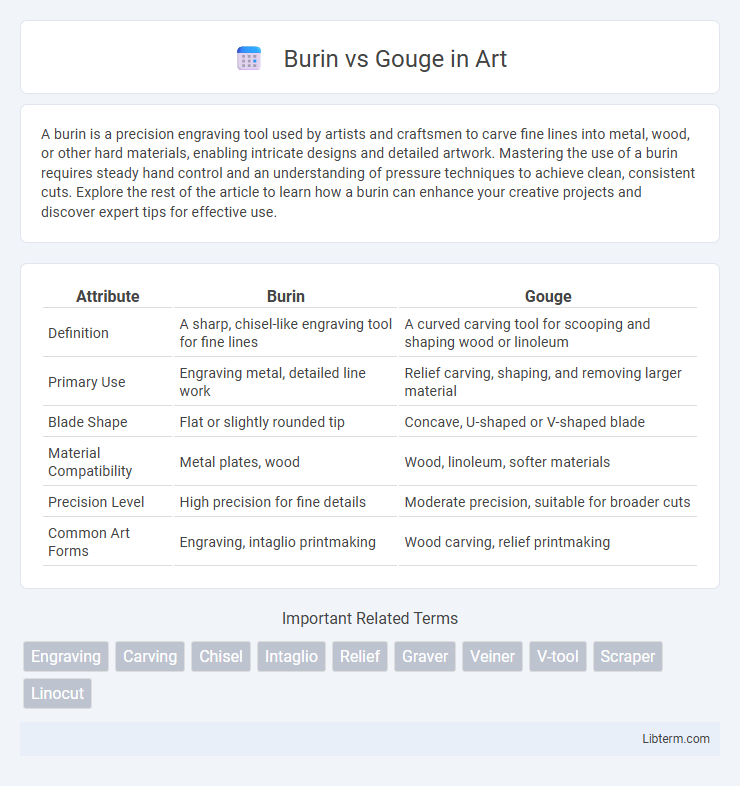A burin is a precision engraving tool used by artists and craftsmen to carve fine lines into metal, wood, or other hard materials, enabling intricate designs and detailed artwork. Mastering the use of a burin requires steady hand control and an understanding of pressure techniques to achieve clean, consistent cuts. Explore the rest of the article to learn how a burin can enhance your creative projects and discover expert tips for effective use.
Table of Comparison
| Attribute | Burin | Gouge |
|---|---|---|
| Definition | A sharp, chisel-like engraving tool for fine lines | A curved carving tool for scooping and shaping wood or linoleum |
| Primary Use | Engraving metal, detailed line work | Relief carving, shaping, and removing larger material |
| Blade Shape | Flat or slightly rounded tip | Concave, U-shaped or V-shaped blade |
| Material Compatibility | Metal plates, wood | Wood, linoleum, softer materials |
| Precision Level | High precision for fine details | Moderate precision, suitable for broader cuts |
| Common Art Forms | Engraving, intaglio printmaking | Wood carving, relief printmaking |
Introduction to Burins and Gouges
Burins and gouges are essential carving tools used in wood and metalwork, each designed with specific blade shapes to achieve different effects. A burin features a sharp, narrow, V-shaped cutting edge ideal for precise engraving and fine detailing, while a gouge has a curved, U-shaped blade suited for scooping and shaping material with smooth, rounded cuts. Mastery of both tools enhances craftsmanship by allowing artists to manipulate textures and contours with accuracy.
Defining Burins: Characteristics and Uses
Burins are precision engraving tools characterized by their sharp, chisel-like tips designed for incising fine lines and detailed patterns on materials like metal, wood, and stone. Typically made from hardened steel, burins feature a square, lozenge, or round-shaped tip that allows for controlled, intricate carving essential in printmaking and sculptural work. Their primary uses include creating detailed designs in intaglio printmaking and adding fine detail in wood engraving, making them indispensable in artistic and technical applications requiring high precision.
Gouges Explained: Features and Applications
Gouges feature a curved cutting edge with a rounded or U-shaped blade, making them ideal for carving concave surfaces and shaping wood. They come in various sweeps, ranging from shallow to deep curves, allowing precise control over material removal and intricate detailing. Common applications include sculpting, cabinetry, and relief carving where smooth, flowing cuts are essential for achieving complex shapes.
Historical Development of Burins and Gouges
Burins trace their origins to prehistoric times, initially crafted from flint and later evolving into finely honed steel tools essential for engraving and printmaking since the Renaissance. Gouges, with their curved blades, have roots in ancient woodworking traditions dating back to Egyptian and Roman civilizations, where they were pivotal for shaping wood and creating intricate designs. Both tools advanced significantly during the Industrial Revolution, with improved metallurgy and specialized forms enhancing their precision and application in art and craftsmanship.
Key Differences Between Burins and Gouges
Burins feature a sharp, chisel-like tip designed for precise engraving and fine-line work, while gouges have a curved, scoop-like blade ideal for carving out larger areas and creating deep grooves. Burins offer high control and detail, making them suitable for intaglio printmaking and metal engraving, whereas gouges excel in woodcut and relief carving due to their ability to remove wood quickly. The distinct blade shapes and cutting angles define their primary functions, with burins used for precise incisions and gouges for shaping and hollowing surfaces.
Materials and Construction of Each Tool
Burins are typically crafted from high-carbon steel, offering exceptional hardness and durability for engraving fine details. Gouges feature a curved steel blade with a sharpened edge, often with a laminated construction combining a hard cutting edge and a softer backing for flexibility. Both tools may incorporate wooden or plastic handles designed for ergonomic grip and precise control during carving or engraving tasks.
Techniques for Using Burins Effectively
Mastering the use of burins involves applying consistent, controlled pressure to achieve precise engraving lines, essential for detailed woodcuts or metal etching. Holding the burin at a low angle enhances stability and allows smooth, continuous cuts, reducing the risk of slips or uneven grooves. Regular sharpening of the steel tip ensures clean incisions, maximizing the tool's efficiency for fine detail work compared to the broader, more forceful gouge techniques.
Gouge Methods for Precision Crafting
Gouge methods for precision crafting utilize curved blades to remove material with controlled scooping motions, ideal for detailed woodcarving and sharpening concave surfaces. The varying sweep angles and bowl shapes of gouges allow artisans to create intricate textures and smooth contours that burins, with their straight and narrow tips, cannot replicate. Selecting the appropriate gouge curvature and bevel angle enhances accuracy and efficiency in fine woodworking and sculpting applications.
Burin vs Gouge: Choosing the Right Tool
Selecting the right tool between a burin and a gouge depends on the desired precision and type of carving. A burin provides fine, controlled lines ideal for detailed engraving on metal or wood, while a gouge offers a curved blade suited for scooping and shaping wood surfaces. Understanding the specific project requirements ensures optimal results by matching the tool's shape and function to the carving technique.
Conclusion: Burin and Gouge in Modern Craftsmanship
Burin and gouge each serve distinct purposes in modern craftsmanship, with the burin excelling in precise engraving and fine detail work, while the gouge is preferred for shaping and carving wood or other materials. Craftsmen often choose tools based on the material and desired texture, leveraging the burin's sharp, narrow tip for intricate line work and the gouge's curved blade for dynamic, rounded cuts. Mastery of both tools enhances versatility and precision in artistic and functional woodworking projects.
Burin Infographic

 libterm.com
libterm.com